Edelstein-Keshet L. Mathematical Models in Biology
Подождите немного. Документ загружается.

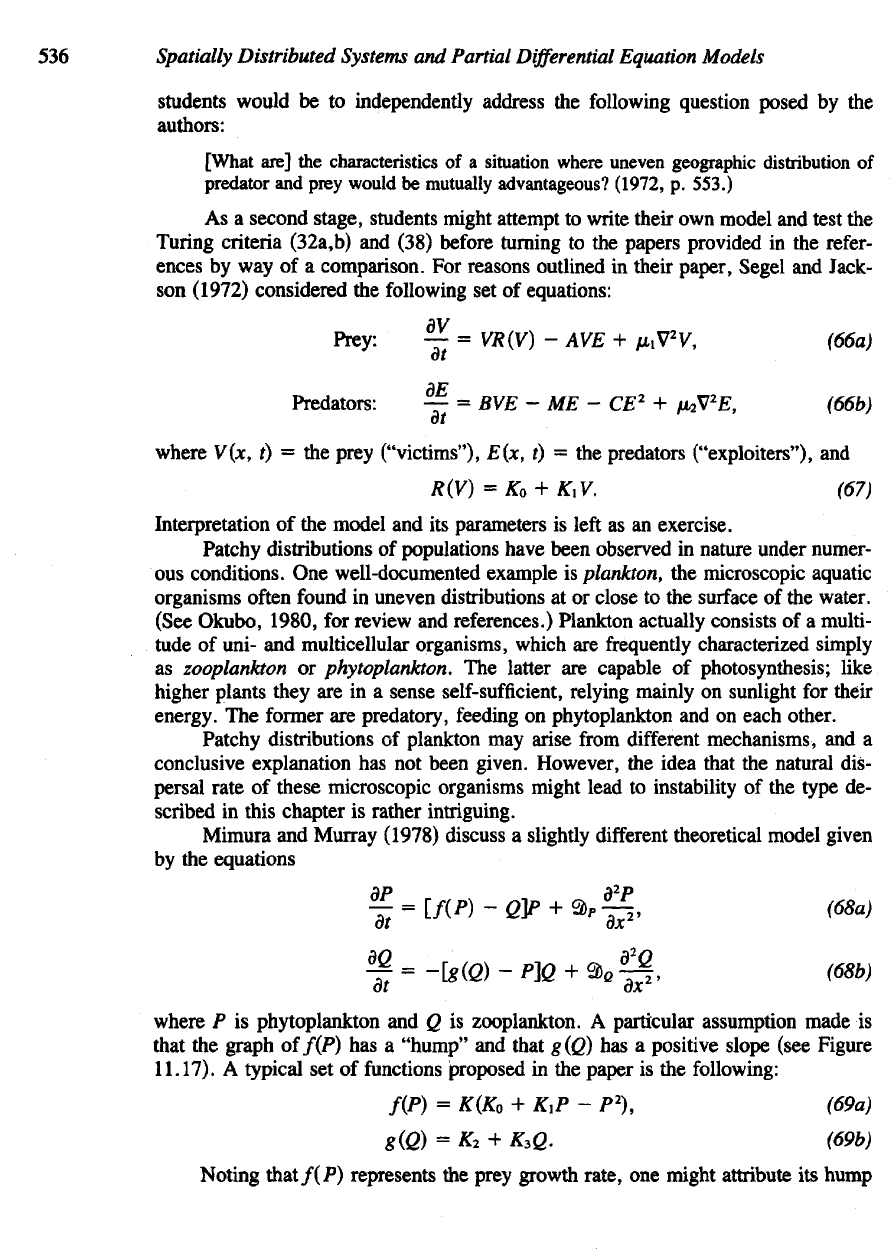
536
Spatially
Distributed
Systems
and
Partial
Differential
Equation
Models
students would
be to
independently address
the
following question posed
by the
authors:
[What are]
the
characteristics
of a
situation where uneven geographic distribution
of
predator
and
prey would
be
mutually advantageous? (1972,
p.
553.)
As
a
second
stage,
students might attempt
to
write their
own
model
and
test
the
Turing
criteria (32a,b)
and
(38) before turning
to the
papers provided
in the
refer-
ences
by way of a
comparison.
For
reasons outlined
in
their
paper,
Segel
and
Jack-
son
(1972) considered
the
following
set of
equations:
where V(x,
t) = the
prey
("victims"),
E(x,
t) = the
predators
("exploiters"),
and
Interpretation
of the
model
and its
parameters
is
left
as an
exercise.
Patchy distributions
of
populations have been observed
in
nature under numer-
ous
conditions.
One
well-documented example
is
plankton,
the
microscopic aquatic
organisms
often
found
in
uneven distributions
at or
close
to the
surface
of the
water.
(See Okubo, 1980,
for
review
and
references.) Plankton actually consists
of a
multi-
tude
of
uni-
and
multicellular organisms, which
are
frequently
characterized simply
as
zooplankton
or
phytoplankton.
The
latter
are
capable
of
photosynthesis; like
higher plants they
are in a
sense
self-sufficient,
relying mainly
on
sunlight
for
their
energy.
The
former
are
predatory, feeding
on
phytoplankton
and on
each other.
Patchy
distributions
of
plankton
may
arise
from
different
mechanisms,
and a
conclusive explanation
has not
been given. However,
the
idea that
the
natural dis-
persal rate
of
these microscopic organisms might lead
to
instability
of the
type
de-
scribed
in
this
chapter
is
rather intriguing.
Mimura
and
Murray (1978) discuss
a
slightly
different
theoretical model given
by
the
equations
where
P is
phytoplankton
and Q is
zooplankton.
A
particular assumption made
is
that
the
graph
of
f(P)
has a
"hump"
and
that g(Q)
has a
positive slope (see Figure
11.17).
A
typical
set of
functions
proposed
in the
paper
is the
following:
Noting
that/(P)
represents
the
prey growth
rate,
one
might attribute
its
hump
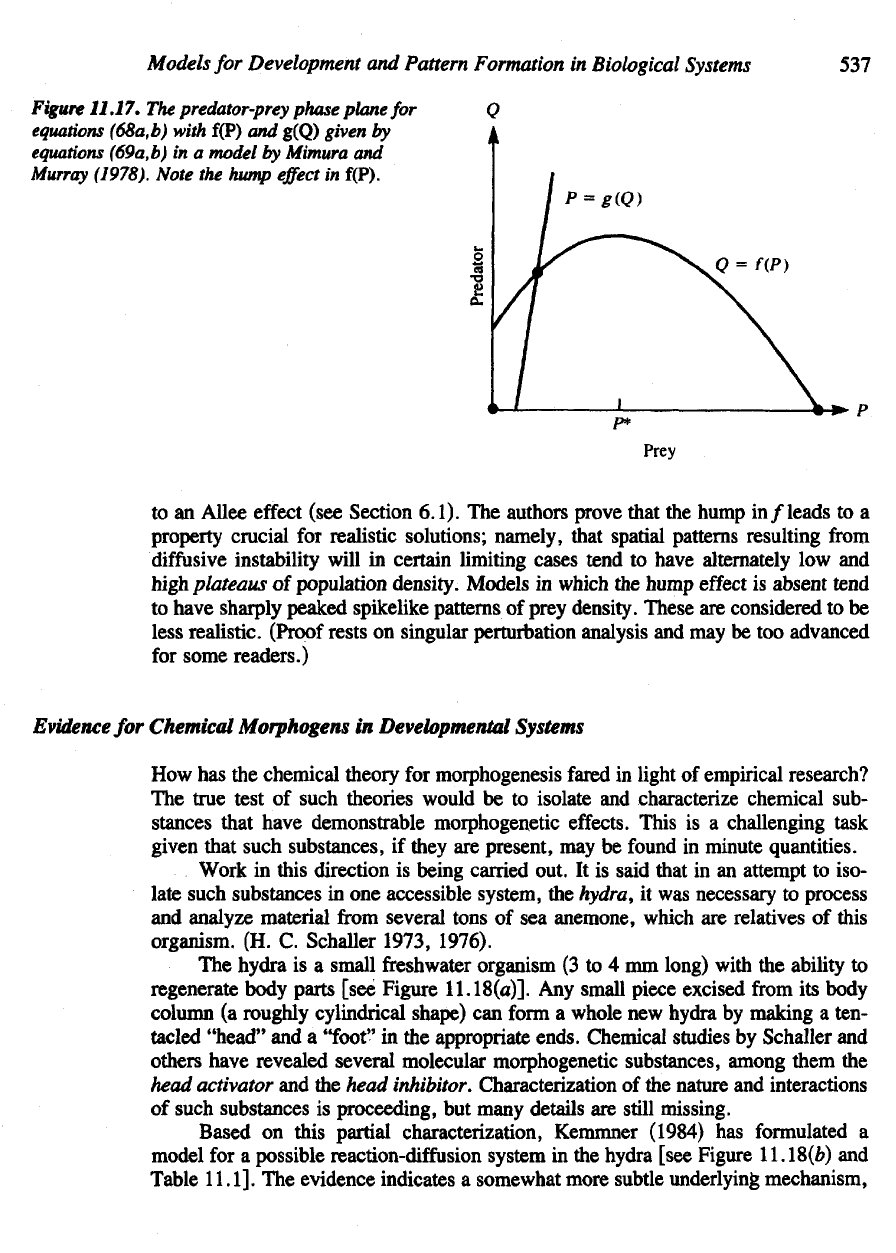
Models
for
Development
and
Pattern Formation
in
Biological
Systems
537
Figure
11.17.
The
predator-prey phase plane
for
equations
(68a,b) with f(P)
and
g(Q) given
by
equations
(69a,b)
in a
model
by
Mimura
and
Murray
(1978). Note
the
hump
effect
in
f(P).
to an
Allee
effect
(see
Section
6.1).
The
authors prove that
the
hump
in/leads
to a
property crucial
for
realistic solutions; namely,
mat
spatial patterns resulting
from
diffusive
instability will
in
certain limiting
cases
tend
to
have alternately
low and
high plateaus
of
population density. Models
in
which
the
hump
effect
is
absent tend
to
have sharply peaked spikelike patterns
of
prey density. These
are
considered
to be
less
realistic.
(Proof rests
on
singular perturbation analysis
and may be too
advanced
for
some readers.)
Evidence
for
Chemical
Morphogens
in
Developmental
Systems
How
has the
chemical theory
for
morphogenesis
fared
in
light
of
empirical research?
The
true test
of
such theories would
be to
isolate
and
characterize chemical sub-
stances that have demonstrable morphogenetic
effects.
This
is a
challenging task
given that such substances,
if
they
are
present,
may be
found
in
minute quantities.
Work
in
this direction
is
being carried out.
It is
said that
in an
attempt
to
iso-
late such substances
in one
accessible
system,
the
hydra,
it was
necessary
to
process
and
analyze material
from
several tons
of sea
anemone, which
are
relatives
of
this
organism.
(H. C.
Schaller
1973,
1976).
The
hydra
is a
small freshwater organism
(3 to 4 mm
long)
with
the
ability
to
regenerate body parts [see Figure
11.18(a)].
Any
small piece excised
from
its
body
column
(a
roughly cylindrical shape)
can
form
a
whole
new
hydra
by
making
a
ten-
tacled
"head"
and a
"foot"
in the
appropriate ends. Chemical studies
by
Schaller
and
others have revealed several molecular morphogenetic substances, among them
the
head
activator
and the
head
inhibitor. Characterization
of the
nature
and
interactions
of
such substances
is
proceeding,
but
many details
are
still missing.
Based
on
this partial characterization, Kemmner
(1984)
has
formulated
a
model
for a
possible reaction-diffusion system
in the
hydra [see Figure
11.18(fe)
and
Table
11.1].
The
evidence indicates
a
somewhat more subtle underlying mechanism,
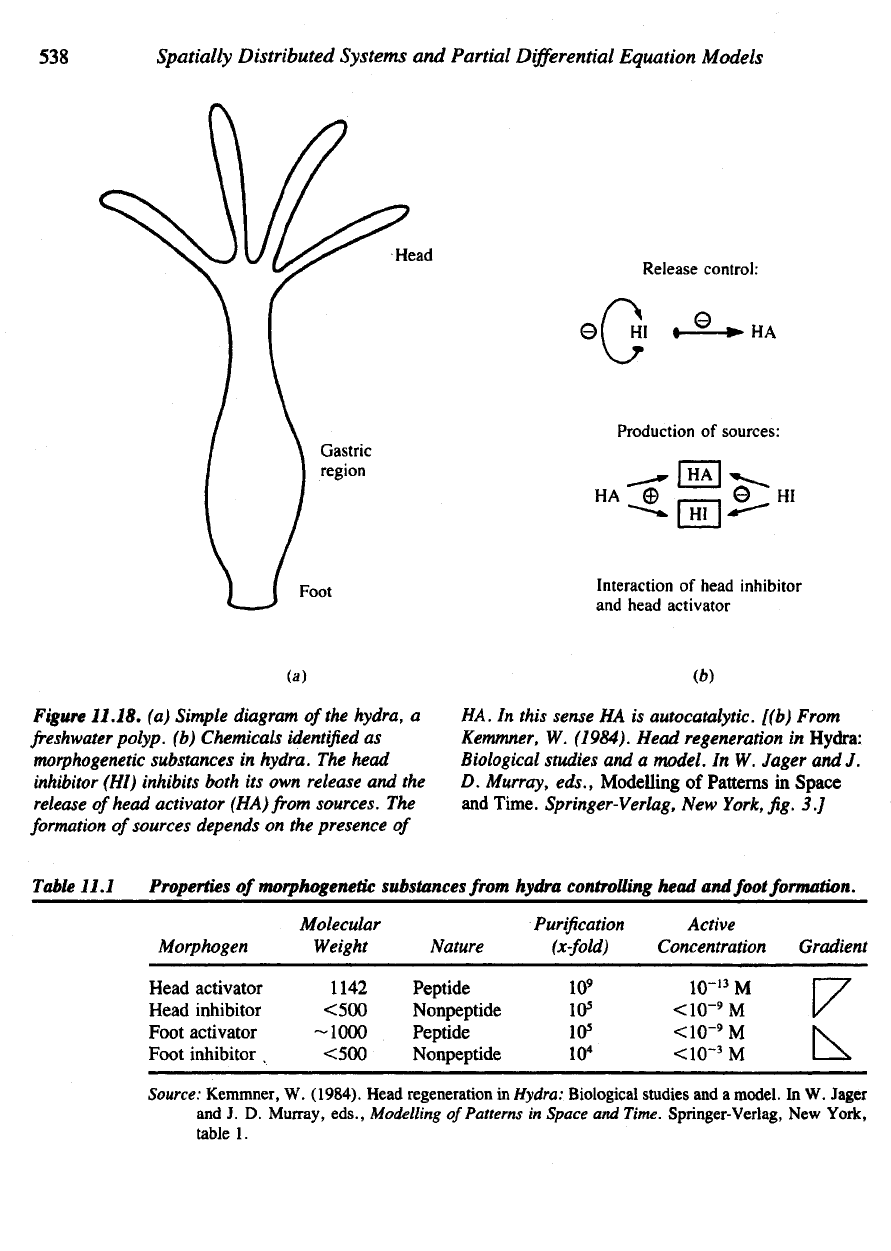
538
Spatially
Distributed Systems
and
Partial
Differential
Equation Models
Figure
11.18.
(a)
Simple diagram
of
the
hydra,
a
freshwater
polyp,
(b)
Chemicals
identified
as
morphogenetic
substances
in
hydra.
The
head
inhibitor
(HI)
inhibits both
its own
release
and the
release
of
head activator (HA)
from
sources.
The
formation
of
sources depends
on the
presence
of
HA. In
this sense
HA is
autocatalytic. [(b) From
Kemmner,
W.
(1984). Head regeneration
in
Hydra:
Biological studies
and a
model.
In W.
Jager
and J.
D.
Murray,
eds.,
Modelling
of
Patterns
in
Space
and
Time.
Springer-Verlag,
New
York,
fig. 3.J
Table
11.1
Properties
of
morphogenetic substances from hydra controlling head
and
foot formation.
Morphogen
Head activator
Head inhibitor
Foot
activator
Foot
inhibitor
,
Molecular
Weight
1142
<500
-1000
<500
Nature
Peptide
Nonpeptide
Peptide
Nonpeptide
Purification
(x-fold)
10
9
10
s
10
5
10
4
Active
Concentration
10-'
3
M
<10~
9
M
<10-
9
M
<10~
3
M
Source: Kemmner,
W.
(1984).
Head regeneration
in
Hydra: Biological studies
and a
model.
In W.
Jager
and J. D.
Murray,
eds.,
Modelling
of
Patterns
in
Space
and
Time. Springer-Verlag,
New
York,
table
1.
Gradient
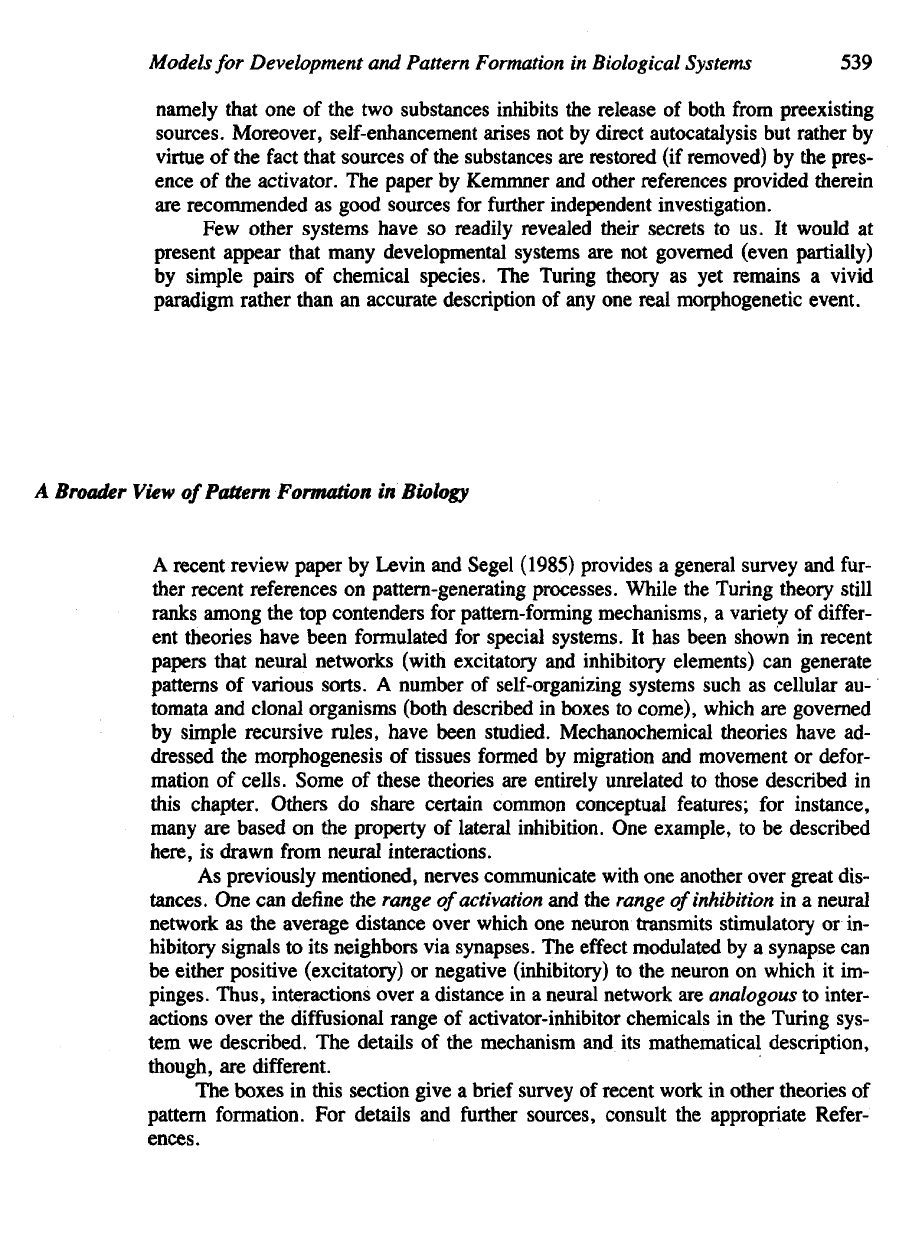
Models
for
Development
and
Pattern
Formation
in
Biological
Systems
539
namely
that
one of the two
substances inhibits
the
release
of
both
from
preexisting
sources. Moreover, self-enhancement arises
not by
direct autocatalysis
but
rather
by
virtue
of the
fact
that sources
of the
substances
are
restored
(if
removed)
by the
pres-
ence
of the
activator.
The
paper
by
Kemmner
and
other references provided therein
are
recommended
as
good sources
for
further
independent investigation.
Few
other systems have
so
readily revealed their
secrets
to us. It
would
at
present appear that many developmental systems
are not
governed (even partially)
by
simple pairs
of
chemical species.
The
Turing theory
as yet
remains
a
vivid
paradigm rather than
an
accurate description
of any one
real morphogenetic event.
A
Broader
View
of
Pattern Formation
in
Biology
A
recent review paper
by
Levin
and
Segel (1985) provides
a
general survey
and
fur-
ther
recent
references
on
pattern-generating
processes.
While
the
Turing theory
still
ranks
among
the top
contenders
for
pattern-forming
mechanisms,
a
variety
of
differ-
ent
theories
have been formulated
for
special
systems.
It has
been shown
in
recent
papers that neural networks
(with
excitatory
and
inhibitory elements)
can
generate
patterns
of
various sorts.
A
number
of
self-organizing systems such
as
cellular
au-
tomata
and
clonal organisms (both described
in
boxes
to
come), which
are
governed
by
simple recursive rules, have been studied. Mechanochemical theories have
ad-
dressed
the
morphogenesis
of
tissues
formed
by
migration
and
movement
or
defor-
mation
of
cells. Some
of
these theories
are
entirely unrelated
to
those described
in
this
chapter. Others
do
share certain common conceptual
features;
for
instance,
many
are
based
on the
property
of
lateral inhibition.
One
example,
to be
described
here,
is
drawn
from
neural interactions.
As
previously mentioned, nerves communicate
with
one
another over great dis-
tances.
One can
define
the
range
of
activation
and the
range
of
inhibition
in a
neural
network
as the
average distance over which
one
neuron transmits stimulatory
or in-
hibitory
signals
to its
neighbors
via
synapses.
The
effect
modulated
by a
synapse
can
be
either positive (excitatory)
or
negative (inhibitory)
to the
neuron
on
which
it im-
pinges. Thus, interactions over
a
distance
in a
neural network
are
analogous
to
inter-
actions over
the
diffusional
range
of
activator-inhibitor chemicals
in the
Turing sys-
tem
we
described.
The
details
of the
mechanism
and its
mathematical description,
though,
are
different.
The
boxes
in
this section give
a
brief survey
of
recent work
in
other theories
of
pattern
formation.
For
details
and
further
sources, consult
the
appropriate Refer-
ences.
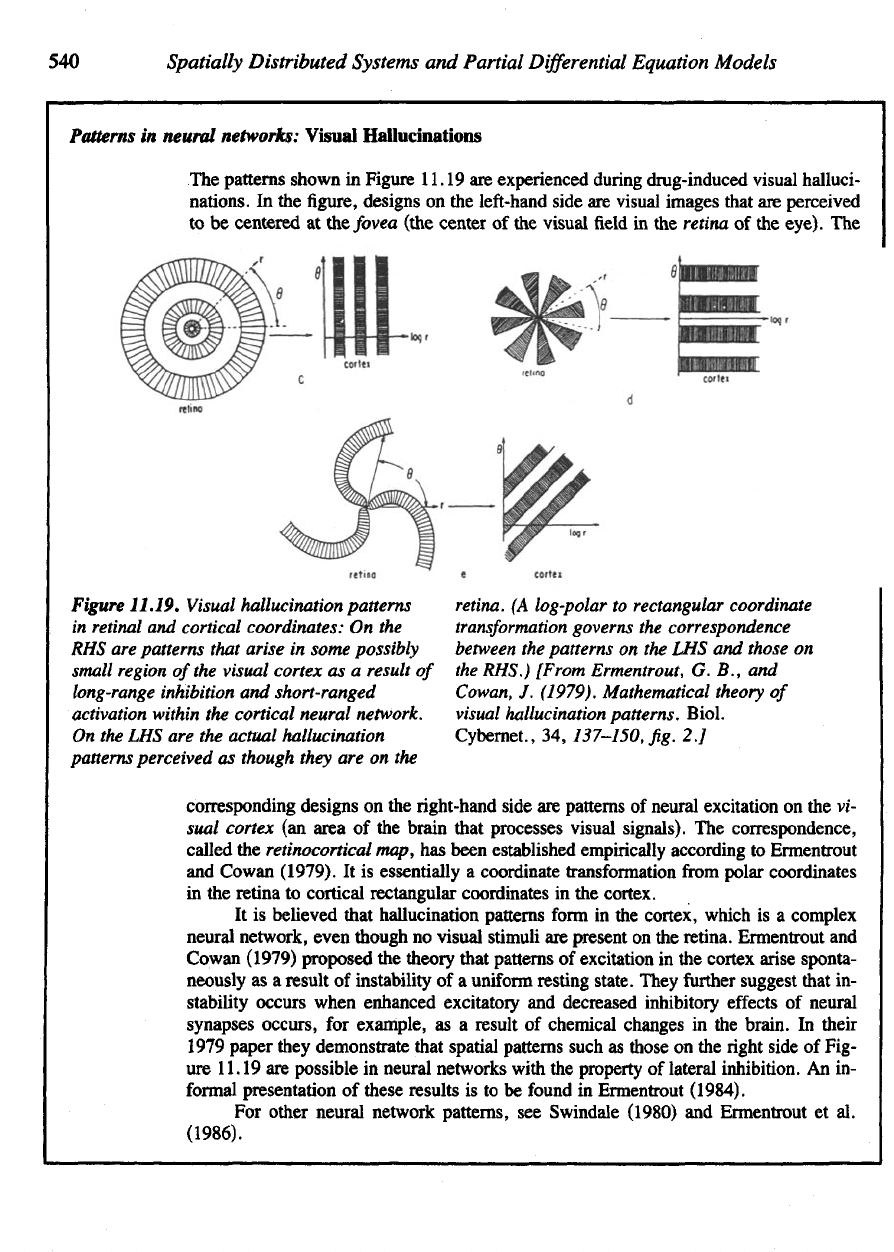
540
Spatially
Distributed Systems
and
Partial
Differential
Equation
Models
Patterns
in
neural networks:
Visual
Hallucinations
The
patterns shown
in
Figure 11.19
are
experienced during drug-induced visual halluci-
nations.
In the
figure, designs
on the
left-hand side
are
visual images that
are
perceived
to be
centered
at
the/ovea
(the
center
of the
visual
field in the
retina
of the
eye).
The
Figure
11.19.
Visual
hallucination patterns
in
retinal
and
cortical coordinates:
On the
RHS
are
patterns that arise
in
some possibly
small
region
of
the
visual cortex
as a
result
of
long-range
inhibition
and
short-ranged
activation
within
the
cortical neural network.
On
the LHS are the
actual hallucination
patterns
perceived
as
though
they
are on the
retina.
(A
log-polar
to
rectangular coordinate
transformation
governs
the
correspondence
between
the
patterns
on the LHS and
those
on
the
RHS.)
[From
Ermentrout,
G. B., and
Cowan,
J.
(1979). Mathematical
theory
of
visual
hallucination patterns. Biol.
Cybernet.,
34,
137–150,
fig. 2.J
corresponding designs
on the right-hand
side
are
patterns
of
neural excitation
on the vi-
sual
cortex
(an
area
of the
brain that
processes
visual signals).
The
correspondence,
called
the
retinocortical map,
has
been established empirically according
to
Ermentrout
and
Cowan (1979).
It is
essentially
a
coordinate transformation
from
polar coordinates
in
the
retina
to
cortical rectangular coordinates
in the
cortex.
It
is
believed that hallucination patterns
form
in the
cortex, which
is a
complex
neural
network, even though
no
visual stimuli
are
present
on the
retina. Ermentrout
and
Cowan (1979) proposed
the
theory that patterns
of
excitation
in the
cortex arise sponta-
neously
as a
result
of
instability
of a
uniform resting
state.
They
further
suggest that
in-
stability occurs when enhanced excitatory
and
decreased inhibitory
effects
of
neural
synapses occurs,
for
example,
as a
result
of
chemical changes
in the
brain.
In
their
1979 paper they demonstrate that spatial patterns such
as
those
on the right
side
of
Fig-
ure
11.19
are
possible
in
neural networks with
the
property
of
lateral inhibition.
An in-
formal
presentation
of
these results
is to be
found
in
Ermentrout (1984).
For
other neural network patterns,
see
Swindale (1980)
and
Ermentrout
et al.
(1986).
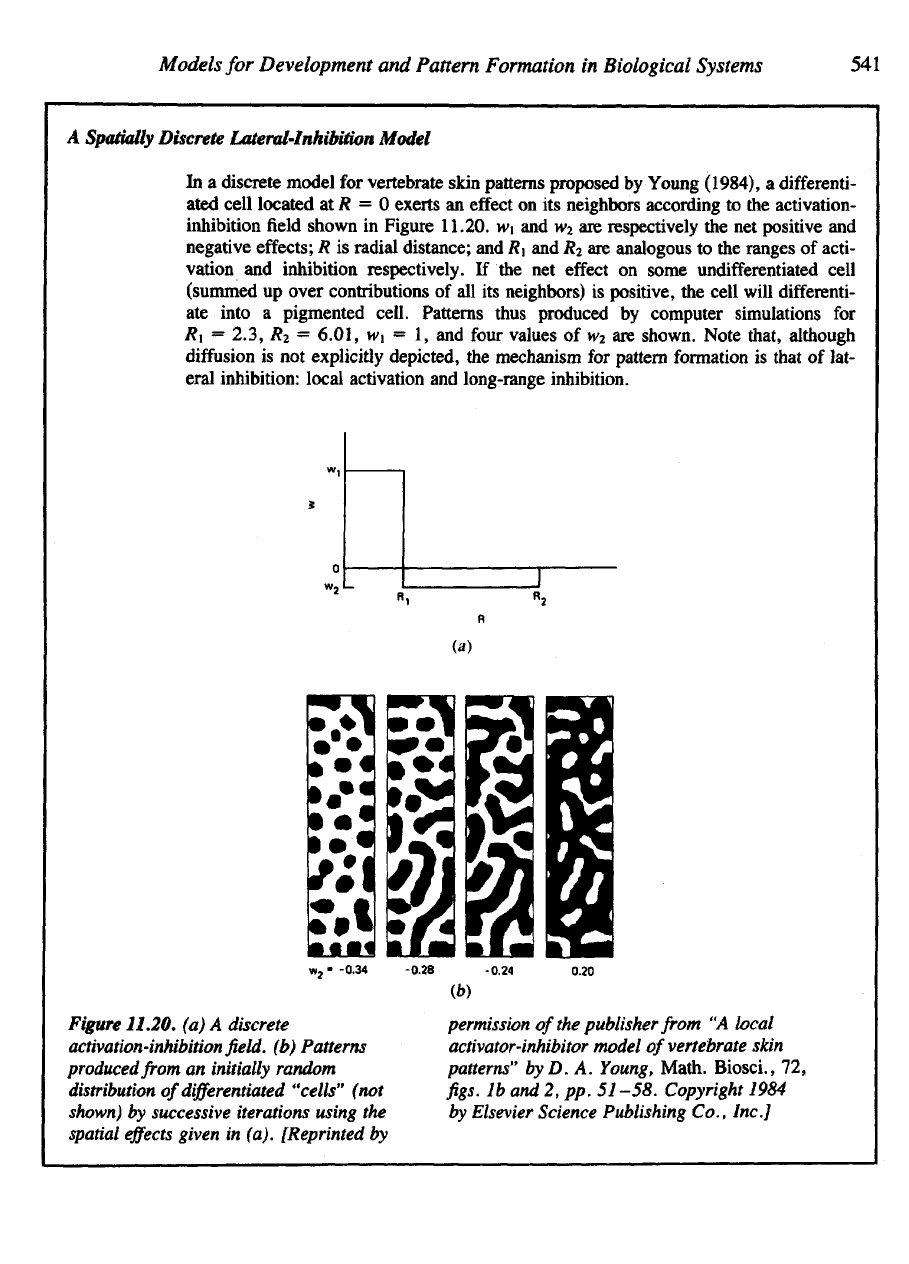
Models
for
Development
and
Pattern Formation
in
Biological
Systems
541
A
Spatially
Discrete
Lateral-Inhibition
Model
In a
discrete
model
for
vertebrate skin patterns proposed
by
Young
(1984),
a
differenti-
ated
cell
located
at R = 0
exerts
an
effect
on its
neighbors according
to the
activation-
inhibition
field
shown
in
Figure
11.20.
wi and w
2
are
respectively
the net
positive
and
negative effects;
R is
radial distance;
and /?i and R
2
are
analogous
to the
ranges
of
acti-
vation
and
inhibition respectively.
If the net
effect
on
some undifferentiated cell
(summed
up
over contributions
of all its
neighbors)
is
positive,
the
cell will
differenti-
ate
into
a
pigmented cell. Patterns thus produced
by
computer simulations
for
/?i
=
2.3,
R
2
=
6.01,
wi = 1, and
four
values
of w
2
are
shown. Note that, although
diffusion
is not
explicitly
depicted,
the
mechanism
for
pattern formation
is
that
of
lat-
eral inhibition:
local
activation
and
long-range inhibition.
Figure
11.20.
(a) A
discrete
activation-inhibition
field, (b)
Patterns
produced
from
an
initially
random
distribution
of
differentiated
"cells" (not
shown)
by
successive iterations
using
the
spatial
effects
given
in
(a).
[Reprinted
by
permission
of
the
publisher
from "A
local
activator-inhibitor
model
of
vertebrate skin
patterns"
by D. A.
Young, Math. Biosci.,
72,
figs. Ib and 2, pp. 51
-58.
Copyright
1984
by
Elsevier
Science Publishing Co., Inc.]
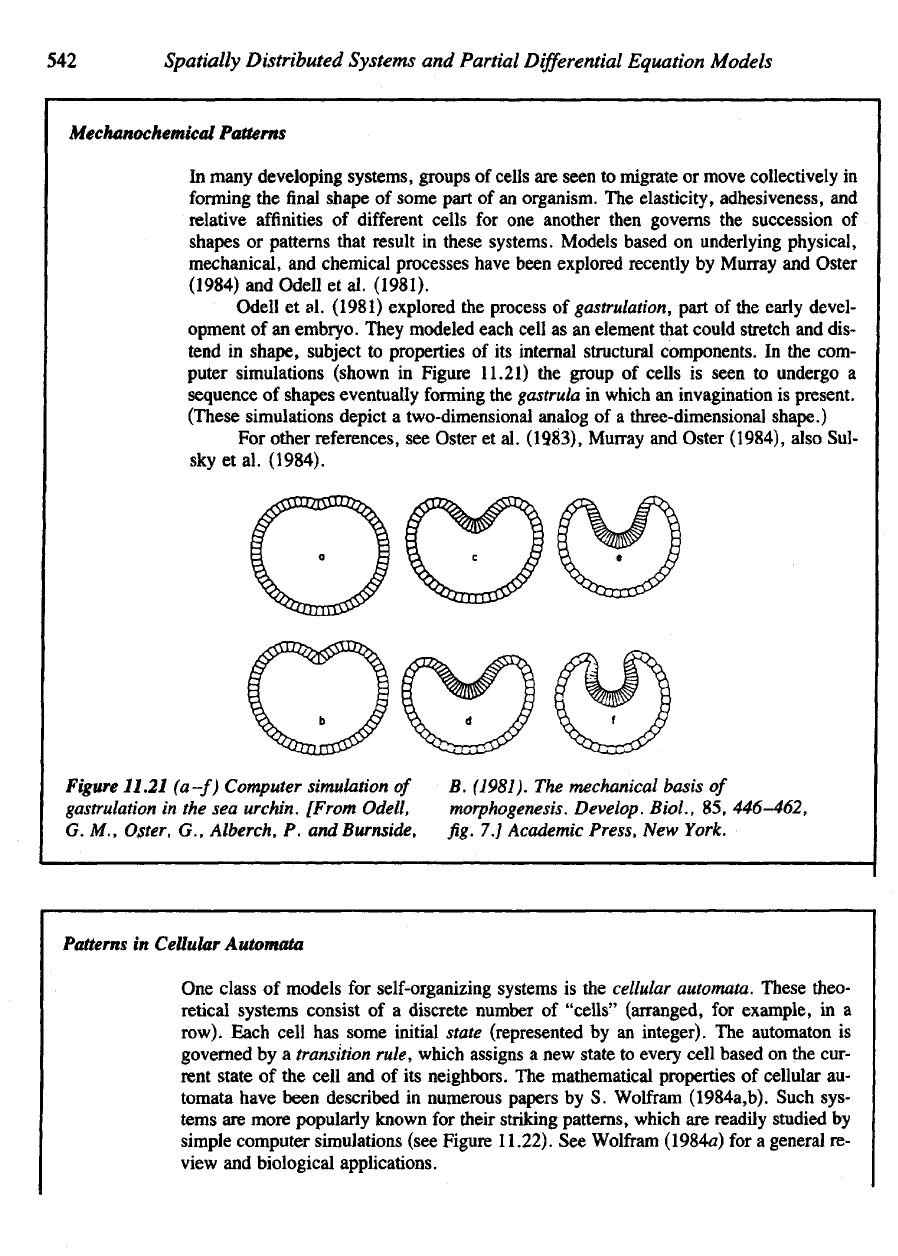
542
Spatially
Distributed
Systems
and
Partial
Differential
Equation
Models
Mechanochemical
Patterns
In
many developing systems, groups
of
cells
are
seen
to
migrate
or
move collectively
in
forming
the final
shape
of
some part
of an
organism.
The
elasticity, adhesiveness,
and
relative
affinities
of
different
cells
for one
another then governs
the
succession
of
shapes
or
patterns that result
in
these systems. Models based
on
underlying physical,
mechanical,
and
chemical
processes
have been explored recently
by
Murray
and
Oster
(1984)
and
Odell
et al.
(1981).
Odell
et al.
(1981) explored
the
process
of
gastrulation, part
of the
early devel-
opment
of an
embryo. They modeled each cell
as an
element that could stretch
and
dis-
tend
in
shape, subject
to
properties
of its
internal structural components.
In the
com-
puter simulations (shown
in
Figure
11.21)
the
group
of
cells
is
seen
to
undergo
a
sequence
of
shapes
eventually forming
the
gastrula
in
which
an
invagination
is
present.
(These simulations depict
a
two-dimensional analog
of a
three-dimensional shape.)
For
other references,
see
Oster
et al.
(1983),
Murray
and
Oster (1984), also Sul-
sky
et al.
(1984).
Figure
11.21 (a-f) Computer simulation
of
gastrulation
in the sea
urchin.
[From
Odell,
G.
M.,
Oster,
G.,
Alberch,
P.
andBurnside,
B.
(1981).
The
mechanical basis
of
morphogenesis.
Develop.
Biol.,
85,
446–462,
fig.
7.]
Academic Press,
New
York.
Patterns
in
Cellular Automata
One
class
of
models
for
self-organizing systems
is the
cellular automata. These theo-
retical
systems
consist
of a
discrete
number
of
"cells"
(arranged,
for
example,
in a
row). Each cell
has
some initial state (represented
by an
integer).
The
automaton
is
governed
by a
transition rule, which assigns
a new
state
to
every
cell
based
on the
cur-
rent
state
of the
cell
and of its
neighbors.
The
mathematical properties
of
cellular
au-
tomata have been described
in
numerous papers
by S.
Wolfram
(1984a,b).
Such sys-
tems
are
more popularly known
for
their striking patterns, which
are
readily studied
by
simple computer simulations (see Figure 11.22).
See
Wolfram
(1984a)
for a
general
re-
view
and
biological applications.
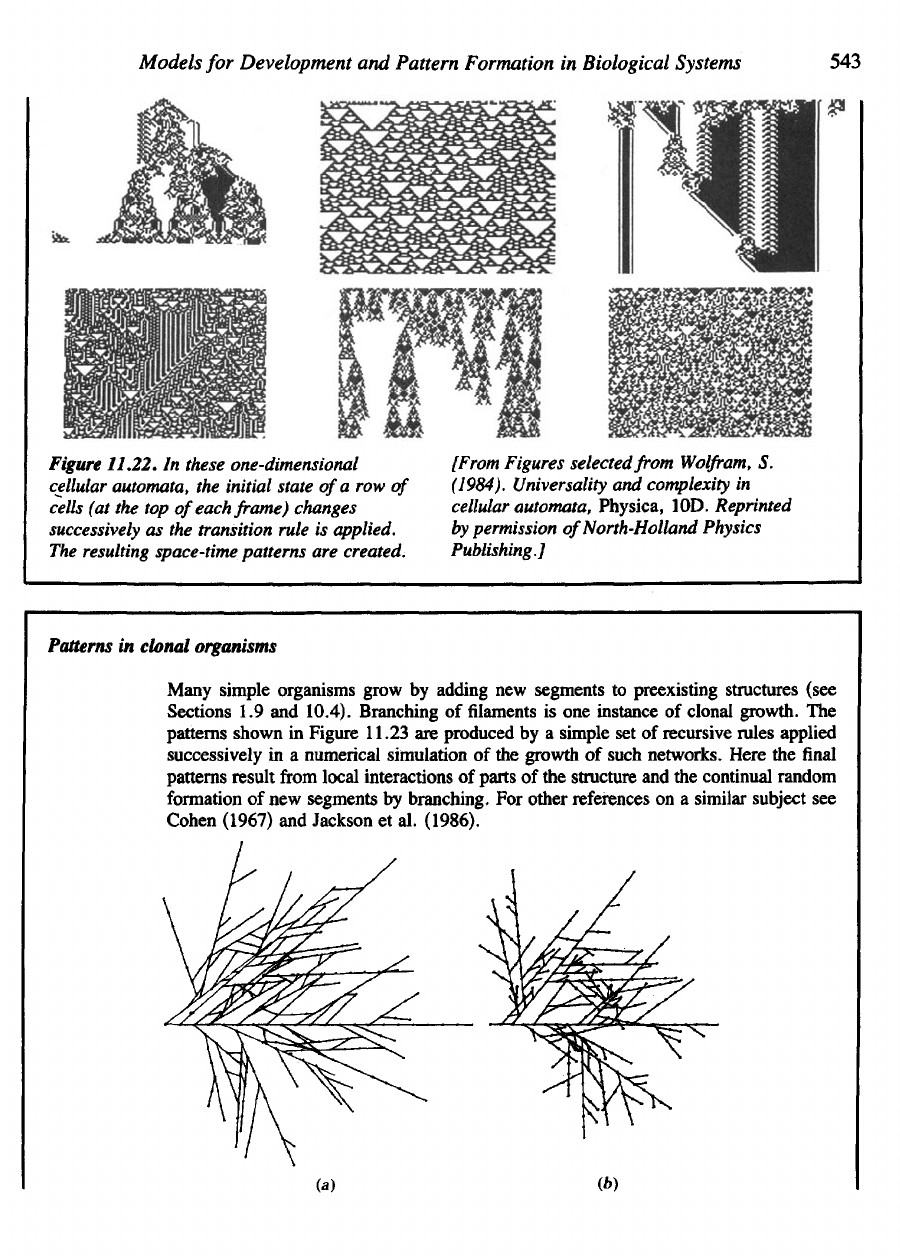
Models
for
Development
and
Pattern Formation
in
Biological
Systems
Figure
11.22.
In
these one-dimensional
cellular
automata,
the
initial state
of a row of
cells
(at the top of
each
frame)
changes
successively
as the
transition rule
is
applied.
The
resulting space-time patterns
are
created.
[From
Figures
selected
from
Wolfram,
S.
(1984).
Universality
and
complexity
in
cellular
automata, Physica, 10D. Reprinted
by
permission
of
North-Holland
Physics
Publishing.]
Patterns
in
clonal organisms
Many
simple organisms grow
by
adding
new
segments
to
preexisting structures (see
Sections
1.9 and
10.4).
Branching
of filaments is one
instance
of
clonal growth.
The
patterns shown
in
Figure 11.23
are
produced
by a
simple
set of
recursive rules applied
successively
in a
numerical simulation
of the
growth
of
such networks. Here
the final
patterns result
from
local interactions
of
parts
of the
structure
and the
continual random
formation
of new
segments
by
branching.
For
other references
on a
similar subject
see
Cohen (1967)
and
Jackson
et al.
(1986).
543
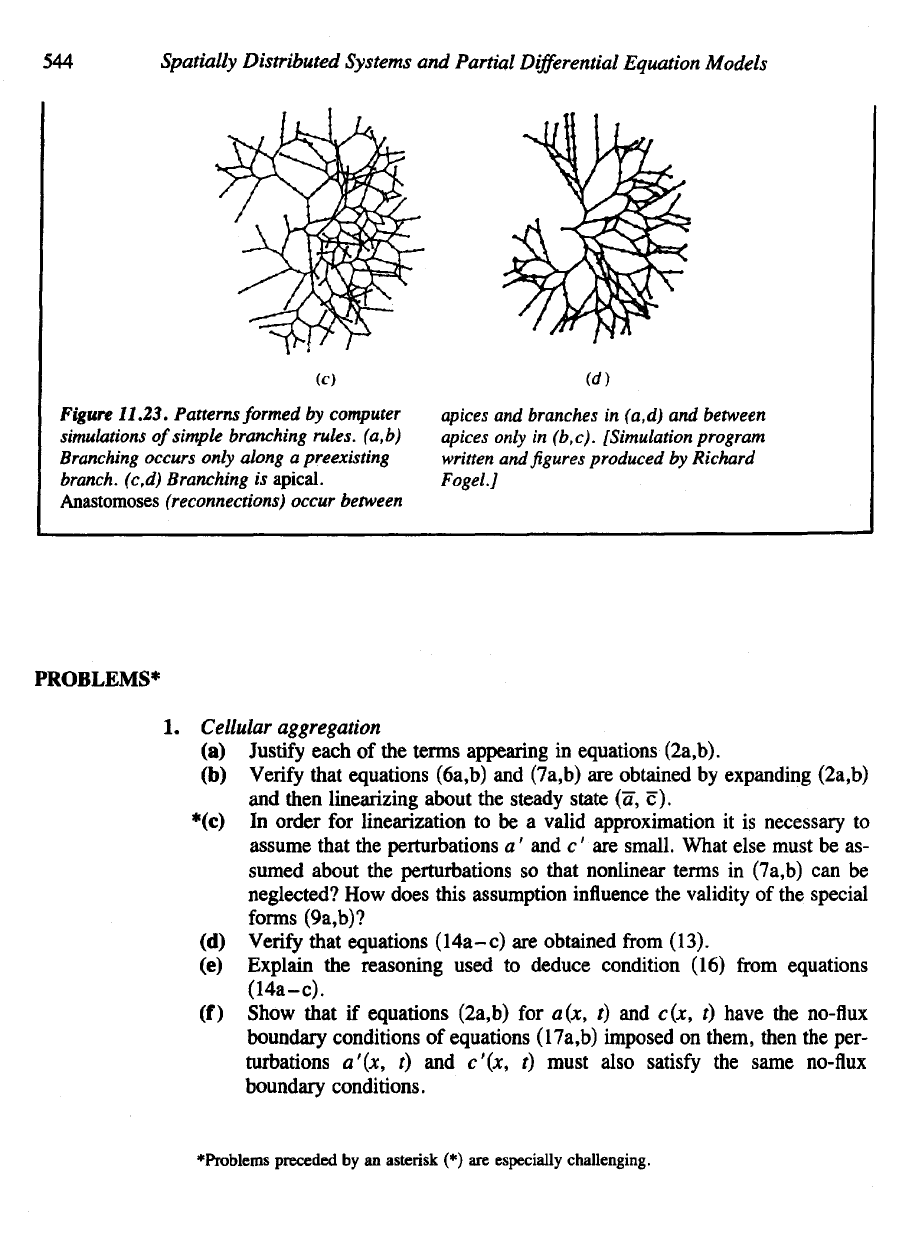
544
Spatially
Distributed Systems
and
Partial
Differential
Equation
Models
Figure
11.23.
Patterns
formed
by
computer
simulations
of
simple
branching
rules.
(a,b)
Branching
occurs
only
along
a
preexisting
branch.
(c,d)
Branching
is
apical.
Anastomoses
(reconnections)
occur
between
apices
and
branches
in
(a,d)
and
between
apices
only
in
(b,c).
[Simulation
program
written
and figures
produced
by
Richard
Fogel.J
PROBLEMS*
1.
Cellular aggregation
(a)
Justify
each
of the
terms
appearing
in
equations (2a,b).
(b)
Verify
that equations (6a,b)
and
(7a,b)
are
obtained
by
expanding (2a,b)
and
then
linearizing
about
the
steady
state
(a, c).
*(c)
In
order
for
linearization
to be a
valid approximation
it is
necessary
to
assume that
the
perturbations
a' and c' are
small. What else must
be as-
sumed about
the
perturbations
so
that nonlinear terms
in
(7a,b)
can be
neglected?
How
does this assumption
influence
the
validity
of the
special
forms
(9a,b)?
(d)
Verify that equations
(14a-c)
are
obtained
from
(13).
(e)
Explain
the
reasoning
used
to
deduce
condition
(16)
from
equations
(14a-c).
(f)
Show that
if
equations (2a,b)
for
a(x,
t) and
c(x,
f)
have
the
no-flux
boundary conditions
of
equations (17a,b) imposed
on
them, then
the
per-
turbations
a'(x,
t) and
c'(x,
t)
must also
satisfy
the
same
no-flux
boundary conditions.
*Problems preceded
by an
asterisk
(*) are
especially challenging.
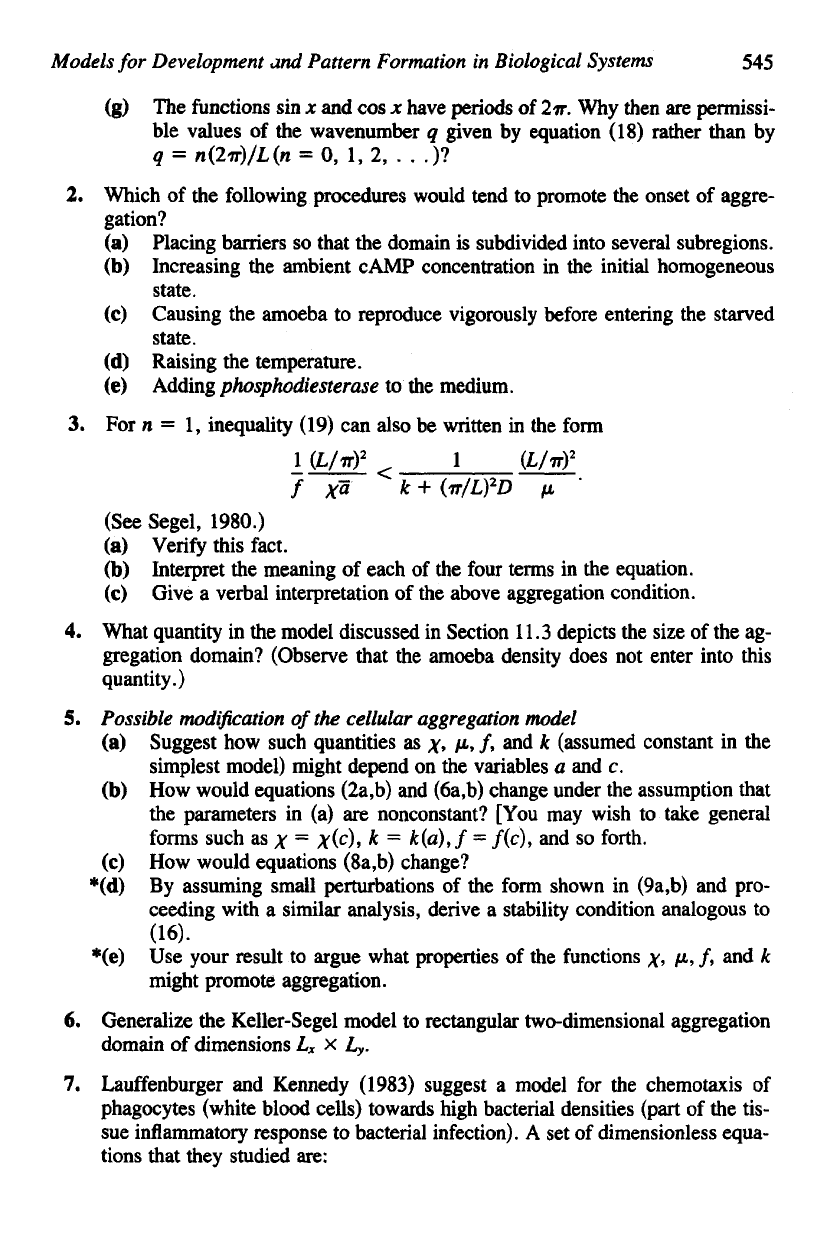
Models
for
Development
and
Pattern Formation
in
Biological
Systems
545
(g) The
functions
sin x and cos x
have
periods
of
2?r
Why
then
are
permissi-
ble
values
of the
wavenumber
q
given
by
equation (18) rather than
by
q
=
n(2ir)/L(n
= 0,
1,2,...)?
2.
Which
of the
following
procedures
would tend
to
promote
the
onset
of
aggre-
gation?
(a)
Placing
barriers
so
that
the
domain
is
subdivided into several subregions.
(b)
Increasing
the
ambient
cAMP
concentration
in the
initial homogeneous
state.
(c)
Causing
the
amoeba
to
reproduce vigorously before entering
the
starved
state.
(d)
Raising
the
temperature.
(e)
Adding
phosphodiesterase
to
the
medium.
3. For n =
1,
inequality (19)
can
also
be
written
in the
form
(See
Segel,
1980.)
(a)
Verify
this fact.
(b)
Interpret
the
meaning
of
each
of the
four
terms
in the
equation.
(c)
Give
a
verbal interpretation
of the
above aggregation condition.
4.
What quantity
in the
model discussed
in
Section
11.3
depicts
the
size
of the ag-
gregation domain? (Observe that
the
amoeba density does
not
enter into this
quantity.)
5.
Possible
modification
of
the
cellular
aggregation
model
(a)
Suggest
how
such quantities
as
\>
/*•>
/>
an
^
k
(assumed constant
in the
simplest model) might depend
on the
variables
a and c.
(b) How
would equations (2a,b)
and
(6a,b) change under
the
assumption that
the
parameters
in (a) are
nonconstant?
[You
may
wish
to
take general
forms
such
as x
=
x(c)>
k
=
^(a),
f
—
/(c),
and so
forth.
(c) How
would equations (8a,b) change?
*(d)
By
assuming small perturbations
of the
form
shown
in
(9a,b)
and
pro-
ceeding with
a
similar analysis, derive
a
stability condition analogous
to
(16).
*(e)
Use
your result
to
argue what properties
of the
functions
\,
/LI,
/, and k
might promote
aggregation.
6.
Generalize
the
Keller-Segel
model
to
rectangular two-dimensional aggregation
domain
of
dimensions
L
x
x
L
y
.
7.
Lauffenburger
and
Kennedy (1983) suggest
a
model
for the
chemotaxis
of
phagocytes (white blood
cells)
towards high bacterial densities (part
of the
tis-
sue
inflammatory response
to
bacterial infection).
A set of
dimensionless equa-
tions that they studied are:
